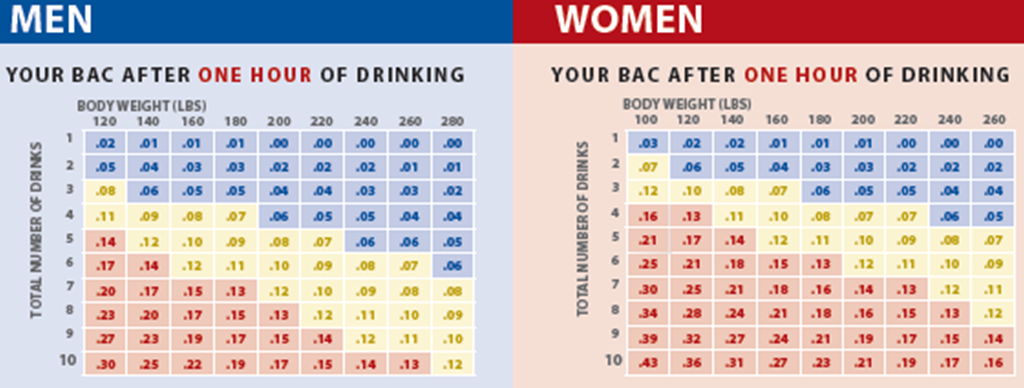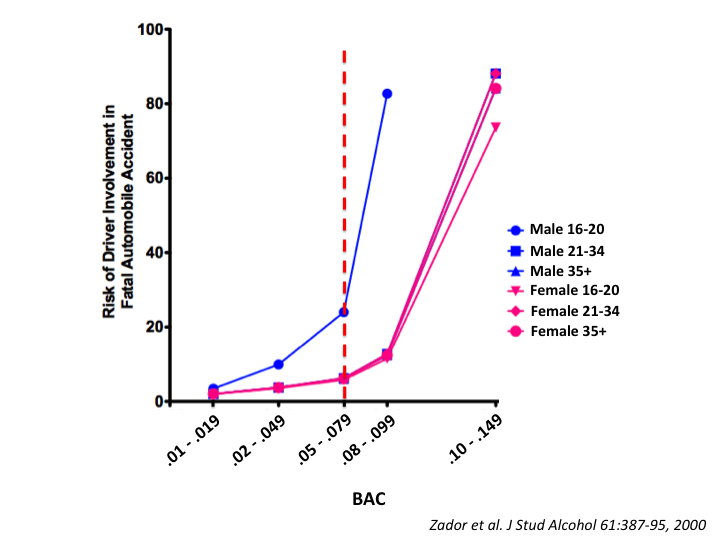If a male and a female who weighs the same consume the same amount of alcohol:
- The male’s BAC will likely be higher
- The female’s BAC will likely be higher
- Their BAC levels would be the same
- None of the above
The correct answer is b. The female’s BAC will likely be higher.
Men and women alike might have the perception that their bodies could handle or process alcohol much in the same manner. Due to this, some women might want to keep up with men while at a party. However similar human bodies might seem, there are still some key differences between the opposite sexes.
Blood alcohol concentration or content (BAC) represents, usually by percentages, how much alcohol is present in a person’s bloodstream. There are different ways to measure BAC, such as through a blood test, a breath test, and a urine test. There are numerous characteristics that factor in how individuals absorb and metabolize alcohol, such as body weight, age, health condition, and — of course — biological sex.
Going back to the question we presented in the beginning, we have a hypothetical situation where a male and a female, having the same weight, consume the same amount of alcohol. Afterward, we showed various, possible consequences, where we showed the correct answer to be the female having higher BAC. In this article, we will explain how and why this is the case.
Why Do Females Have Higher BAC?
Women in general have a higher tendency to get drunk or intoxicated faster because they have lower levels of fluids in their bodies, which means that alcohol does not get diluted immediately. A woman’s body only contains 52% water. Comparing it to a man’s 61% water content, it could be safely assumed that a male is capable of diluting more alcohol. Conversely, more alcohol stays within a woman’s body, giving her an increased BAC.
Commonly, females possess an increased amount of body fat as compared to males with similar weights. This feature likewise affects how the body handles consumed alcohol. Since the toxic substance could not be dispersed in fat, more alcohol would then remain within the female body. This would also heighten her body’s BAC levels.


Within the liver, an enzyme that serves to break down toxic alcohol is located. This enzyme is called alcohol dehydrogenase (ADH). In general, alcohol dehydrogenase action varies by age, gender, and even location or geography. Young females and young males do not process alcohol at equal rates — this is because ADH is not expressed as highly in females as it is in males. This leads to females having a higher BAC percentage.
Changes in hormone levels also affect the capability of a woman’s body to metabolize alcohol. For example, during the premenstrual phase, a woman’s capability to metabolize the substance slows down. This causes more alcohol to flow into her bloodstream; consequently, the female gets intoxicated faster. Medications with estrogen, such as pills for birth control, likewise slow down the female body’s ability to process alcohol.
What Other Factors Affect A Person’s BAC?
Aside from gender-specific differences, there are other things that factor in the flux of an individual’s blood alcohol concentration levels.
- Food or Drink Intake
Once you have ingested any alcoholic beverage, the alcohol immediately gets absorbed into your bloodstream, with the aid of your stomach and small intestine. Drinking a non-alcoholic beverage, particularly water, will help dilute the alcohol you have already consumed. This, along with eating food, will likewise slow the absorption rate of alcohol. However, doing these will not completely stop your body from absorbing the alcohol from your drinks.
It should also be noted that drinks with higher alcohol concentration percentages get absorbed more quickly, and so do carbonated alcoholic beverages. Getting absorbed more quickly means having a higher BAC rate.
- Consumption Speed and Amount of Drinks
Drinking too much and/or too fast will never be a good sign for you. Your liver, being the primary organ that processes alcohol, could only metabolize so much until it reaches maximum capacity. The average human body processes 10 grams of alcohol within about an hour. It would not be able to properly metabolize the substance if you proceed to drink large amounts of alcohol within a short time span. Moreover, doing such could lead you to alcohol poisoning and other alcohol-related diseases.
- Individual’s Drinking Patterns
There are people who are occasional (or social) drinkers, individuals who enjoy leisure drinking, and who prefer to drink at the minimum, not going overboard. There are also others who abusively intake alcohol, nearly living and breathing the substance. These patterns determine how much alcohol gets into your bloodstream, which, in turn, affects the rest of your body, especially your brain. The brain is perhaps the most vulnerable organ since alcohol (ethanol) can easily get through its selectively permeable barrier. The toxic substance could affect your brain so instantly, from making you disinhibited and euphoric to making you lethargic, unconscious, and in the worst cases, dead.
Aside from the aforementioned side effects of alcohol intake, there are more illnesses or diseases that a heavy drinker can contract. Under those, we can find various hepatic diseases or diseases where the liver is targeted. When a woman drinks alcohol while she is pregnant, her baby might develop Fetal Alcohol Syndrome. On a more psychological note, there are mental disorders that could be classified as substance-induced, where substance includes alcohol if the individual fits the appropriate diagnostic criteria.


Conclusion
Even if they have the same weight, when a man and a woman drink the same amount of alcohol, the woman will be the one who would get higher BAC levels or blood alcohol concentration. Thus, it will garner her an alcohol-induced impairment faster than the male. This is mainly due to varieties in physiological components, hormones, rate of metabolism, and body composition.
Of course, there are also some factors in BAC change that are less gender specific. These factors include drinking patterns, speed of consumption, amount consumed, and presence of food and/or non-alcoholic drinks in your system.
Nevertheless, consuming alcohol has its risks that everyone should be aware of, such as developing various diseases, some of which could lead to death. Therefore, responsible drinking must be practiced, and appropriate efforts must be made if you suspect that you or someone you know might be suffering from alcoholism problems.
Also read: Truths About Alcohol Advertisements
